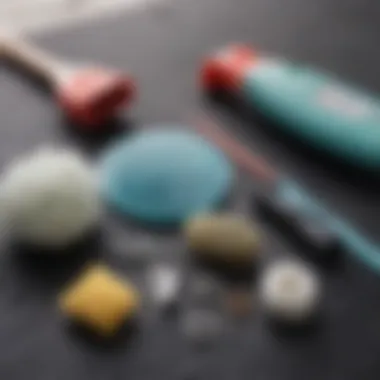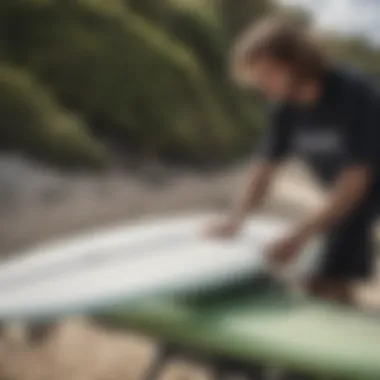Selecting the Ideal Fiberglass Repair Kit for Surfers


Intro
When it comes to surfing, every enthusiast knows that a well-maintained surfboard is key to a greater experience on the waves. Unfortunately, wear and tear are inevitable, and knowing how to properly repair your board can make all the difference. In this guide, we will explore the intricacies of selecting the perfect fiberglass repair kit tailored for surfboards. Not only is this important for prolonging the life of your gear, but it also impacts your performance, ensuring you stay afloat both literally and figuratively.
Choosing a repair kit may seem straightforward, but the nuances involved can often trip up even seasoned surfers. Each kit offers unique features and components that cater to specific types of damage. From dings and cracks to larger holes, understanding the essential aspects of repair can save both time and money.
Additionally, we’ll dive into aspects like the application techniques and the expertise required to accomplish a seamless fix. Armed with this knowledge, surfers will be empowered not just to make informed decisions when purchasing, but also to achieve professional-grade repairs themselves.
Let’s take a closer look at the surf gear and equipment that will enhance your surfboard maintenance ventures.
Prologue to Fiberglass Repair Kits
When you're riding the waves, you don't want a cracked surfboard holding you back. Learning about fiberglass repair kits is essential to keep your board in top-notch condition. These kits are not just a band-aid solution; they offer a chance to rejuvenate and maintain your beloved equipment for years to come.
Having a sound understanding of these kits makes a big difference in surfboard longevity. Whether you’re a seasoned surfer or just starting, knowing when and how to make repairs can save you both time and money. Proper maintenance and timely repairs avoid the need for costly replacements and enhance your overall surfing experience.
In this section, we'll look at the necessity of repairs, delve into the common types of damage surfboards face, and why having a trusty repair kit on hand is not just a luxury, but a necessity.
Understanding the Need for Repairs
Surfboards are adventurous companions, but they do take a beating. A fall during a ride, a collision with a rock, or simply riding over the reef can lead to unexpected damage. These mishaps can lead to cracks, dings, or even complete breaks. If you ignore these issues, it can lead to bigger problems down the line. A well-timed repair is often the difference between a quick fix and a board that's beyond saving.
Regular repairs keep the structural integrity of your surfboard intact. Beyond aesthetics, damage can affect performance, such as stability during riding or how well the board cuts through water. Thus, understanding how to effectively use a fiberglass repair kit greatly enhances your connection to the surf. It lends a sense of empowerment, knowing you can tackle repairs firsthand, maintaining not just the board, but the memories it carries.
Common Types of Damage in Surfboards
For the avid surfer, recognizing the patterns of damage is crucial. Here are the common culprits that usually need addressing:
- Dings: Small cracks or holes often caused by impacts with rocks or hard surfaces.
- Delamination: A more significant issue where layers separate, often due to water ingress. It’s like peeling paint but in surfboard form.
- Scratches: The little nicks and cuts, more cosmetic, but left unchecked could lead to bigger issues.
- Cracks: These can be very serious, especially if they run deeply into the board.
But fret not; each of these issues can often be remedied with a trusty fiberglass repair kit. Knowing the damage type you’re facing allows you to select the right kit tailored to your needs, setting you up for a successful repair.
Understanding the intricacies of what can go wrong allows surfers to take proactive measures. In the coming sections, we’ll dive deeper into the specifics of fiberglass repair kits, helping you choose one that genuinely meets your needs.
Key Components of a Fiberglass Repair Kit
Understanding the key components of a fiberglass repair kit is crucial for anyone serious about maintaining their surfboards. It’s not just about the materials; it’s about ensuring the longevity and performance of your prized possession. A well-chosen repair kit can mean the difference between a seamless ride on the waves and an unexpected wipeout due to a structural failure.
The importance of having the right components cannot be understated. If you are aiming for durability and strength, then each part of the kit must be carefully selected. Having the correct resin, fiberglass cloth, and the right tools can turn a mediocre repair into a professional-grade restoration. When you're out there riding, you want to be confident your gear can withstand the forces of nature and the wear and tear of the sport.
Resin Types and Their Characteristics
When it comes to fiberglass repair, not all resins are created equal. Two primary types of resin dominate the scene: polyester and epoxy.
- Polyester Resin: This is the more commonly used type, well-known for its affordability and decent strength. It’s arguably the go-to option for many surfers. However, it has some drawbacks. It can be brittle and less resistant to UV rays, which can lead to yellowing over time. If you're doing light repairs and want to keep costs down, it’s a viable pick.
- Epoxy Resin: For those who demand the best, epoxy resin is the heavyweight contender. It offers superior strength and flexibility, making it ideal for more serious damage repair. Plus, it's more resistant to the elements, meaning your repairs will last longer. The downside? It can be pricier than polyester, and the curing process may require more patience.


Choosing the right resin involves assessing the extent of the damage and considering your budget. Think about how often you use your board and the conditions you typically surf in.
Fiberglass Cloth: Options and Benefits
Fiberglass cloth is another essential piece in the puzzle. The cloth adds structural integrity to the repair, so its quality can make or break your project.
- Weight: You’ll find fiberglass cloth in various weights, typically measured in ounces per square yard. Lighter cloths (around 4 oz) are suitable for minor repairs, while heavier options (like 6 oz or 10 oz) are perfect for more severe damage or for areas that experience high stress.
- Weave: The weave of the fiberglass can also impact the final product. A plain weave gives you flexibility, while a twill weave can offer greater durability. Depending on your need, you may prefer one over the other.
The right fiberglass cloth can significantly improve how well your repair holds up. If the repair area is larger or experiences lots of stress, consider going with a heavier fabric to ensure long-lasting results.
Additional Tools and Supplies
Beyond resin and cloth, a few other tools and supplies can make your fiberglass repair experience smoother and more efficient.
- Mixing Tools: Accurate measurement and mixing are vital for getting your resin to cure correctly. Invest in good mixing cups and stir sticks. For best results, find options that are disposable to avoid any residues that might mess up future mixes.
- Sanding Pads: Once the resin is cured, you’ll want to sand down any rough edges to ensure a smooth finish. Having a range of pads for different grits – from rough to fine – will help you achieve that polished look.
- Acetone or Solvents: For clean-up purposes, acetone is your best friend. It helps remove any excess resin from tools or accidents.
- Protective Gear: Don’t skimp on safety. Wear gloves and a mask, especially when working with resins and solvents. Your health should never take a backseat in any repair situation.
By equipping yourself with these key components, you'll not only be prepared for any repair task but also capable of extending the life of your surfboard considerably.
"A stitch in time saves nine," as they say. Tackling those little repairs before they escalate is the way to go!
In summary, understanding the characteristics of resin types, the benefits of various fiberglass cloths, and the additional tools needed will equip you to choose the best fiberglass repair kit. This knowledge will empower you to make informed decisions and tackle repairs with confidence.
Evaluating Different Fiberglass Repair Kits
Selecting the right fiberglass repair kit isn’t just a matter of picking one off the shelf. It’s important to thoroughly evaluate the options available to ensure you select a kit that meets your specific needs. This section delves into the critical aspects of comparing different fiberglass repair kits to find the one that can stand up to the wear and tear of surfing.
Understanding the various elements that go into these kits can significantly affect not only the quality of the repair but also the longevity of your surfboard. A well-evaluated kit means less time spent fixing your gear and more time spent catching waves. Here’s where the rubber meets the road: knowing your options can make all the difference.
Comparative Analysis of Popular Kits
When diving into the realm of fiberglass repair kits, some names tend to surface more than others. It’s essential to analyze these popular kits to gain insight into their effectiveness and value. A few standout options would be the Bondo Fiberglass Resin, TotalBoat Epoxy Repair Kit, and West System Epoxy Kit.
- Bondo Fiberglass Resin
This kit is notably popular for its quick-drying capabilities, making it a go-to for surfers in a hurry. Bondo’s product is straightforward to apply, but it can lack the flexibility some advanced kits provide over time. - TotalBoat Epoxy Repair Kit
What sets this one apart is its strong bonding and long-lasting effects. Surfers who don’t want to deal with repairs every season find this kit appealing. The only drawback? It can take a bit longer to cure. - West System Epoxy Kit
A favorite among seasoned surfers, this kit offers exceptional versatility. The various hardeners available mean you can customize your repair for colder or hotter environments. However, it requires a bit more know-how than some of the simpler options.
These kits have their own strengths and weaknesses, and much of the choice boils down to personal preferences and surfing habits. The benefits and limitations of each should be weighed against your specific repair needs.
Criteria for Choosing the Right Kit
With numerous options available, establishing criteria for choosing the right fiberglass repair kit can be beneficial. Here are some critical elements to consider:
- Type of Damage: Are you fixing minor dings or major structural issues? The type of damage assesses which kit is best suited to your needs.
- Skill Level: If you’re a beginner, you might prefer a simpler kit with clear instructions to avoid unnecessary frustration.
- Drying Time: Depending on your urgency, you may want a faster-drying solution. Consider how quickly you need your surfboard ready for the water.
- Flexibility and Setup: Look for kits that offer flexibility in application, as boards face different stresses in the water.
- Material Quality: Higher-quality materials can lead to a longer-lasting repair, which is especially important for avid surfers.
"Choosing the right fiberglass repair kit is more than a shopping decision—it's about prolonging the life of your favorite surfboard and enhancing your overall experience on the waves."
Taking the time to evaluate these criteria will improve your chances of making a well-informed choice, which ultimately results in more effective repairs and a more enjoyable surfing experience.
Step-by-Step Guide to Using a Fiberglass Repair Kit


Understanding how to properly use a fiberglass repair kit is crucial for anyone wanting to maintain their surfboard. Each step is instrumental in ensuring a solid repair, reducing the chance of future damage. The smooth application process lays the groundwork for the durability and effectiveness of repairs. Knowing these steps not only helps surface enthusiasts restore their boards but also builds confidence in their repair skills.
Preparation: Assessing Damage and Gathering Materials
Before diving into repairs, it’s essential to gauge the extent of the damage. Look closely at any dings, cracks, or punctures. If the damage is minor, such as a small chip, the repair will likely be straightforward. Larger cracks, however, might require more extensive work. Take your time during this evaluation, as overlooking damage may lead to larger problems later.
Once you’ve assessed the damage, the next logical step is to gather all necessary materials. Typically, a fiberglass repair kit includes resin, hardener, fiberglass cloth, sandpaper, and mixing sticks. Here’s a simple checklist:
- Resin and hardener: These substances will create a durable bond.
- Fiberglass cloth: Provides structural strength to the repair.
- Sandpaper: Essential for smoothing out any rough edges.
- Cleaning supplies: Ensure the surface is clean before applying the kit.
Having everything at hand allows for a smooth workflow without interruptions. It’s like gearing up for a surf session; you wouldn’t hit the waves without your board and wetsuit!
Applying the Repair: Techniques for Success
With your spot assessed and materials collected, it's time to get to the nitty-gritty of the repair process. Start by cleaning the damaged area thoroughly. Remove any dirt, wax, or loose fragments that may interfere with the adhesive process. A clean surface is crucial for ensuring that your repair sticks like peanut butter to jelly.
Next, mix the resin and hardener according to the manufacturer’s instructions. Precision here is key; improper ratios can lead to weak repairs. When applying, be generous yet careful. Use a brush or a spatula to coat the fiberglass cloth evenly with the resin mixture. Lay the cloth over the damaged area and press it down firmly. It should seep into the cracks, ensuring a tight bond. Remember, it’s better to apply a few thin layers rather than one thick one.
Finishing Touches and Curing Process
Once the fiberglass cloth is in place, it’s time for the finishing touches. While it’s tempting to rush ahead, patience is needed at this stage. Once the repair is complete, allow it to cure as per the guidance in your repair kit. Curing time varies between brands but generally falls between a few hours to overnight.
After the repair has cured, grab that sandpaper and go to town! Smooth out any rough edges until the surface is flush with the board. This might feel like the final touches to a masterpiece, making sure everything aligns perfectly.
Finally, it’s crucial to apply a sealant or topcoat if advised in your kit instructions. This can offer additional protection against future wear and tear. As with any fine piece of art, completing these steps ensures your surfboard isn’t just ready to hit the water, but it will also look good doing it.
Proper preparation and technique will not only enhance the durability of your repair but also prolong the life of your surfboard—an investment worth taking seriously.
Expert Tips for Effective Repairs
Repairing a surfboard can be a daunting task, especially if you’re new to fiberglass work. Yet, having a few expert tips in your back pocket can make a world of difference. These pointers not only help you avoid pitfalls but also enhance the quality of your repairs. Furthermore, knowing these tricks can extend the lifespan of your surfboard.
Avoiding Common Mistakes
When tackling fiberglass repairs, there are some mistakes that can trip you up, often leading to more damage down the road.
- Skipping Surface Preparation
Many beginners overlook the importance of properly preparing the surface before applying resin. Cleaning the area thoroughly with acetone or similar solvents is crucial. Any dust or contaminants can compromise the bond. - Mixing Errors
Getting the resin and hardener ratios wrong is another common issue. Precise measurements are key. Always follow the manufacturer’s instructions to a tee. An incorrect mix can result in a weak repair that chips away. - Ignoring Curing Times
Rushing the process is a common pitfall. It can be tempting to hop back on your board after making repairs, but giving your work adequate time to cure ensures that it holds together when faced with the stresses of surfing. - Rushing the Sanding Process
Once cured, some may be too eager to sand their repairs before they’re fully set. Patience is vital here. Take your time, and you'll achieve a smoother finish that blends seamlessly with your surfboard.
By steering clear of these common blunders, you set yourself up for success and make each repair more effective.
Best Practices for Long-lasting Repairs
Achieving nifty repairs is not just about fixing what's broken; it’s about doing it right so that your board remains in top shape. Here are a few best practices to consider:
- Follow Thorough Claims
Whenever possible, use reliable or recommended products. Not all fiberglass resins are created equal, and choosing high-quality materials results in more durable repairs. - Layering Techniques
Apply multiple layers of fiberglass cloth when working on larger damages. This adds strength and stability, making your repair far more resilient in the long run. A well-structured application is key here. - Proper Ventilation
When you’re working with chemicals, ensuring good airflow is essential. Strong odors and fumes can be harmful. A well-ventilated workshop will keep you feeling fresh and focused on your repairs. - Regular Check-ins on Your Board
After performing repairs, make it a habit to regularly inspect your surfboard. Keeping an eye on any potential issues before they escalate can save you a lot of grief later. - Practice Makes Perfect
Lastly, don’t shy away from practicing. Whether on an old board or spare materials, honing your technique will pay off when you need to mend your main ride.


By adhering to these best practices, you ensure greater durability of your repairs and ultimately enhance your overall surfing experience.
Remember, a well-maintained surfboard doesn’t just ride the waves; it becomes a trusted companion on your surfing adventures.
Implementing these expert tips, along with avoiding common errors, will boost your confidence in handling fiberglass repairs. This knowledge equips you with the ability to care for your equipment and keep your surfing game at its peak.
Maintaining Your Surfboard After Repairs
Once the dust has settled and you've repaired your surfboard, that's only step one in ensuring it serves you well for many waves to come. Maintaining your surfboard after these repairs is critical. Think of it like owning a car; if you ignore the oil changes and tire pressures, you can end up with a costly breakdown. So, why leave your surfboard at risk of future damages when a little TLC goes a long way?
Proper maintenance not only enhances the durability of the repairs but also extends the lifespan of your surfboard. A well-maintained board doesn't just perform better; it also helps keep your investment intact. Here are some insights into maintaining your surfboard effectively.
Preventative Measures to Avoid Future Damage
Taking steps to prevent damage before it happens can save surfers a world of trouble later on. Here are several preventative measures to consider:
- Storage: Always store your surfboard in a designated place, away from direct sunlight and extreme temperatures. A board bag is a great choice for protection against unexpected incidents.
- Avoid Hard Surfaces: Do not leave your surfboard on hard surfaces, especially concrete or rocky areas. This could lead to dings or scratches that’ll need repairing.
- Rinse After Use: After a session, rinse your board with fresh water to remove any salt residue. Salt can degrade the resin over time, leading to premature wear.
- Use Tape on Fins: If you're transporting your board frequently, consider using tape to protect your fins and rails from minor bumps and scrapes.
"Taking care of your board is much like caring for your surf skills; it requires patience and intention. 'A rusted surfboard is a wasted surfboard.'"
By integrating these preventative measures into your routine, you can significantly reduce the likelihood of further damage to your surfboard.
Regular Maintenance Tips
Just like you wouldn't skip leg day at the gym, you shouldn't take regular maintenance for granted. Keeping your surfboard in top condition doesn't have to involve grueling tasks. Here are some maintenance tips that are achievable yet effective:
- Inspect Regularly: Make it a habit to inspect your board for potential issues every time you come back from the water. Look for cracks, worn areas or anything unusual.
- Clean Thoroughly: Give your board a good clean regularly. Use a gentle soap and a soft sponge to avoid scratching the surface. Remember to rinse thoroughly!
- Check Fins and Leash: Regularly ensure your fins are secure and check the leash for any signs of wear and tear. Replace them as needed to avoid losing your board to the ocean.
- Store Properly: As reiterated earlier, proper storage is key. Avoid stacking boards on top of each other as this can warp them over time.
Maintaining your surfboard is not just a chore—it’s an investment in preserving your enjoyment on the waves. By adopting these practices, you enhance not only the integrity of your repairs but also the overall performance and longevity of your surfboard. In the end, it comes down to how much you respect your gear and how much you want to continue riding those perfect waves.
Ending
When it comes to surfing, the lifeblood of the sport resides in the condition of your board. This article emphasizes the crucial role that proficient repairs play in maintaining surf culture. Any seasoned surfer can attest to how a well-kept board can not only enhance performance but can also prolong enjoyment on the water. After all, a damaged surfboard can be like trying to dance with two left feet; hardly efficient and more than a tad frustrating.
The Importance of Proficient Repairs in Surf Culture
In surf culture, the connection between the rider and the wave is sacred. A surfboard isn't just a piece of equipment; it's part and parcel of the whole experience. When damage occurs—be it from a rough landing off a wave, or a careless moment on the beach—it becomes essential to address those repairs promptly and effectively.
Proficient repairs ensure that every session on the water is met with confidence instead of worry. Surfers who choose to maintain their boards well demonstrate respect for their gear and the ocean's waves. In essence, proper repairs reflect a deeper commitment to the sport, showcasing a surfer’s understanding of the sands of time and the inevitability of wear and tear.
Additionally, high-quality repairs can save you money in the long run, preventing further damage and the necessity for replacements. The satisfaction gained from not only fixing your board but doing it skillfully is unmatched. Each repair adds a story to your board, reinforcing the adventure that every surfer cherishes.
Final Thoughts on Choosing a Repair Kit
Choosing the right repair kit is akin to selecting the perfect board; it requires self-awareness and knowledge. As you look into fiberglass repair kits, remember the significance of matching the kit's components to your specific needs and level of expertise. You wouldn't go into battle without the right gear, so don’t go into the repair fray unprepared.
Pay heed to the resin types and fiberglass cloth options. Understand what you need before making a decision. While the market is flooded with kits, it's vital to sift through them like a seasoned surfer finding the best break. Performance, reliability, and ease of use should be at the forefront of your decision-making process.
Consider also the additional tools that come with the kit. They can transform the repair experience from a daunting task into a manageable, even enjoyable one. Ultimately, a savvy surfboard enthusiast knows that the best gear enhances not just performance, but also the entire experience on the water.
"The ocean is calling, but a broken board won't answer. Repair like you ride—passionately and with purpose."
When you invest time and effort into selecting a fiberglass repair kit, you are one step closer to preserving your surfboard’s integrity and ensuring that your surf adventures remain uninterrupted. So, go ahead and take the plunge. With a well-chosen kit and some dedication, the waves await.















